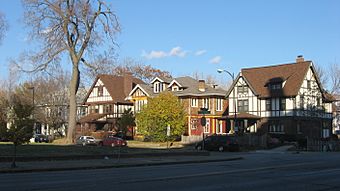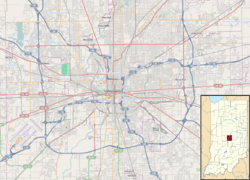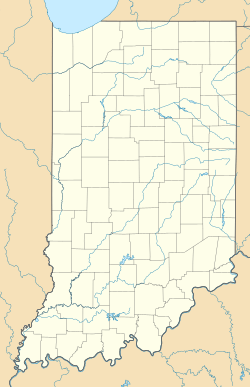Herron–Morton Place Historic District facts for kids
Quick facts for kids |
|
|
Herron–Morton Place Historic District
|
|

Talbott Street in the southwestern part of the district
|
|
| Location | Roughly bounded by Central Ave., 16th, Pennsylvania, and 22nd Sts., Indianapolis, Indiana |
|---|---|
| Area | 147 acres (59 ha) |
| Built | 1822 |
| Architect | Multiple |
| Architectural style | Classical Revival, Queen Anne, Tudor Revival |
| NRHP reference No. | 83000131 |
| Added to NRHP | June 16, 1983 |
Herron–Morton Place is a special historic neighborhood in Indianapolis, Indiana. It's known for its beautiful old homes and for being a place where people work to restore and renew old buildings. This area is located between East 16th Street, East 22nd Street, North Pennsylvania Street, and Central Avenue.
Contents
A Look Back: History of Herron–Morton Place
Early Days: The 19th Century
In 1859, the state of Indiana bought the land that is now Herron–Morton Place. At that time, it was mostly empty land. It was used as the home for the Indiana State Fair, a big event where people showed off farm animals and products.
When the American Civil War began, this area became very important. It was first used as a place where soldiers for the Indiana Volunteer Infantry would gather before going to war. Later, it became a prison camp for Confederate soldiers called Camp Morton. After the war ended, the land went back to being the fairgrounds.
By 1890, the area was divided into lots for homes. Soon after, some of the wealthiest families in Indianapolis started building large, fancy houses here.
Growth and Change: The 20th Century
At the start of the 1900s, the area just north of 16th Street was one of the most elegant neighborhoods in Indianapolis. It was called Morton Place, named after Indiana's governor, Oliver Morton. Many famous politicians, doctors, business leaders, and artists lived here.
Two well-known Indiana artists, T.C. Steele and William Forsyth, started their famous Hoosier Group art school in Morton Place in 1888. Later, in 1895, John Herron's gift helped create the John Herron Art Institute. This institute built a new main building and an art museum in Morton Place. The Herron Museum later became the Indianapolis Museum of Art.
The Morton Place neighborhood did very well until the Great Depression in the 1930s. During the 1930s and World War II, many large houses were divided into smaller apartments. From the 1950s to the 1970s, some houses were sadly lost due to fires or being torn down.
In 1983, Herron–Morton Place was added to the National Register of Historic Places. This means it was recognized as a special place worth protecting. In 1986, it became a historic preservation district. The district includes 574 important buildings. These buildings show different styles of architecture, like Classical Revival, Queen Anne, and Tudor Revival.
Modern Times: The 21st Century
The Herron School of Art and Design, which is Indiana's top art school, moved to new buildings in 2000 and 2005. These new buildings are on the Indiana University-Purdue University Indianapolis campus.
The original Herron School of Art buildings are now home to Herron High School. This is a special charter high school that focuses on classical liberal arts. These old school buildings are still important parts of the Herron–Morton Place Historic District.
In 2016, the Willard and Josephine Hubbard House was also added to the National Register of Historic Places on its own.
Community Life in Herron–Morton Place
Since 1950, Herron–Morton Place has hosted the Talbot Street Art Fair. This is an annual art fair held on Talbott Street every June. Artists show and sell their work here.
The Herron–Morton Place Neighborhood Association was started in 1976. This group works to help renovate homes, encourage new housing, reduce crime, and build a strong community spirit.
The Herron–Morton Place Neighborhood Foundation helps raise money to take care of a historic neighborhood park. This park is on the 1900 block of Alabama Street. The Foundation also supports other efforts to make the neighborhood beautiful. They plan several events each year to raise money for the park. Two popular events are the annual Oktoberfest in late September and the bi-annual home tour. They also have Rock 'N' Romp, a yearly event for families.




